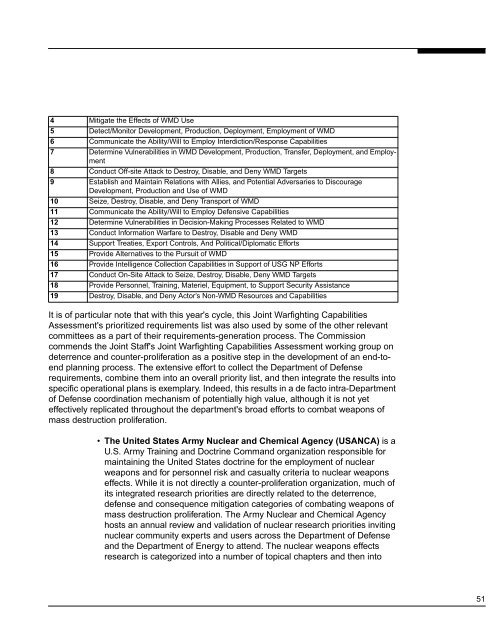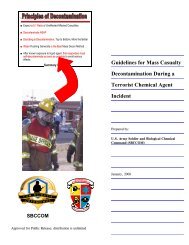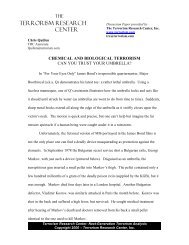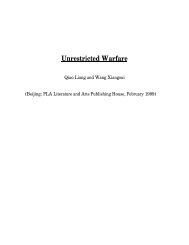Combating Proliferation of Weapons of Mass Destruction
Combating Proliferation of Weapons of Mass Destruction
Combating Proliferation of Weapons of Mass Destruction
You also want an ePaper? Increase the reach of your titles
YUMPU automatically turns print PDFs into web optimized ePapers that Google loves.
4 Mitigate the Effects <strong>of</strong> WMD Use5 Detect/Monitor Development, Production, Deployment, Employment <strong>of</strong> WMD6 Communicate the Ability/Will to Employ Interdiction/Response Capabilities7 Determine Vulnerabilities in WMD Development, Production, Transfer, Deployment, and Employment8 Conduct Off-site Attack to Destroy, Disable, and Deny WMD Targets9 Establish and Maintain Relations with Allies, and Potential Adversaries to DiscourageDevelopment, Production and Use <strong>of</strong> WMD10 Seize, Destroy, Disable, and Deny Transport <strong>of</strong> WMD11 Communicate the Ability/Will to Employ Defensive Capabilities12 Determine Vulnerabilities in Decision-Making Processes Related to WMD13 Conduct Information Warfare to Destroy, Disable and Deny WMD14 Support Treaties, Export Controls, And Political/Diplomatic Efforts15 Provide Alternatives to the Pursuit <strong>of</strong> WMD16 Provide Intelligence Collection Capabilities in Support <strong>of</strong> USG NP Efforts17 Conduct On-Site Attack to Seize, Destroy, Disable, Deny WMD Targets18 Provide Personnel, Training, Materiel, Equipment, to Support Security Assistance19 Destroy, Disable, and Deny Actor’s Non-WMD Resources and CapabilitiesIt is <strong>of</strong> particular note that with this year's cycle, this Joint Warfighting CapabilitiesAssessment's prioritized requirements list was also used by some <strong>of</strong> the other relevantcommittees as a part <strong>of</strong> their requirements-generation process. The Commissioncommends the Joint Staff's Joint Warfighting Capabilities Assessment working group ondeterrence and counter-proliferation as a positive step in the development <strong>of</strong> an end-toendplanning process. The extensive effort to collect the Department <strong>of</strong> Defenserequirements, combine them into an overall priority list, and then integrate the results intospecific operational plans is exemplary. Indeed, this results in a de facto intra-Department<strong>of</strong> Defense coordination mechanism <strong>of</strong> potentially high value, although it is not yeteffectively replicated throughout the department's broad efforts to combat weapons <strong>of</strong>mass destruction proliferation.• The United States Army Nuclear and Chemical Agency (USANCA) is aU.S. Army Training and Doctrine Command organization responsible formaintaining the United States doctrine for the employment <strong>of</strong> nuclearweapons and for personnel risk and casualty criteria to nuclear weaponseffects. While it is not directly a counter-proliferation organization, much <strong>of</strong>its integrated research priorities are directly related to the deterrence,defense and consequence mitigation categories <strong>of</strong> combating weapons <strong>of</strong>mass destruction proliferation. The Army Nuclear and Chemical Agencyhosts an annual review and validation <strong>of</strong> nuclear research priorities invitingnuclear community experts and users across the Department <strong>of</strong> Defenseand the Department <strong>of</strong> Energy to attend. The nuclear weapons effectsresearch is categorized into a number <strong>of</strong> topical chapters and then into51







